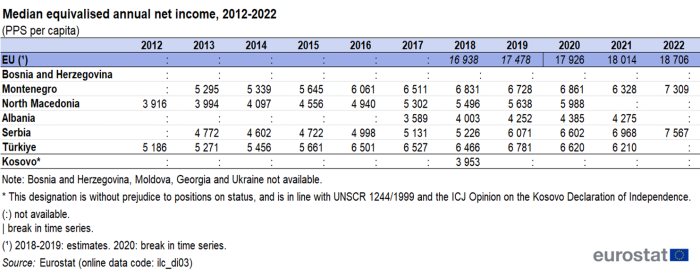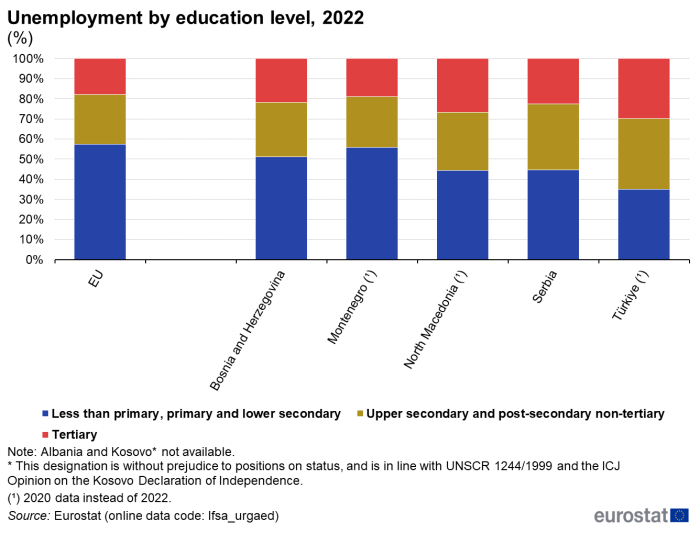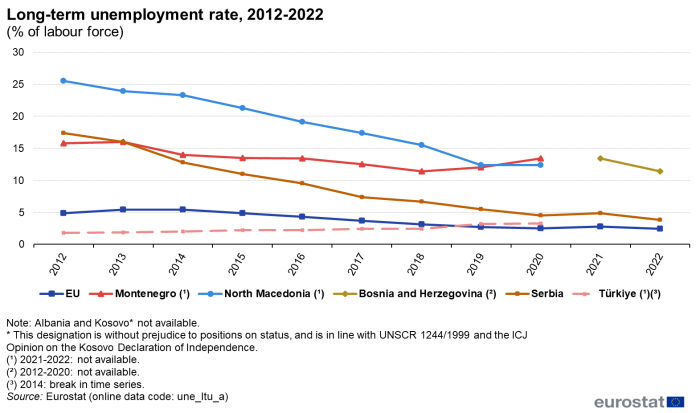Data from May 2024.
Planned article update: June 2025.
Highlights
In 2022, Serbia had the highest median income per person among the candidate countries and potential candidate, at 7 567 purchasing power standards, around 40% of the EU level (18 706 PPS). Montenegro followed with 7 309 PPS.
Income disparities are greater in the candidate countries and potential candidate than in the EU, with the most recent available Gini coefficients ranging from 31.4 in North Macedonia (2020) to 44.2 in Kosovo (2018), compared with 29.6 in the EU in 2022.
In Türkiye, the share of persons living in households with very low work intensity was 8.1% in 2020, slightly higher than in the EU (7.7%). The shares were higher in the other candidate countries and potential candidate, ranging from 11.6% in Albania to 37.6% in Kosovo (2018).
The harmonised index of consumer prices (HICP, base 2015=100) grew exponentially in Türkiye between 2012 and 2022, from 79.3 to a nearly five times higher index value in 2022 (370.8).
The long-term unemployment rate in Serbia fell from 17.4% in 2012 to 3.8% in 2022, i.e. to a level closer to the EU rate in 2022 (2.4%).
This article is part of an online publication and provides information on a range of statistics related to living conditions in the candidate countries and potential candidate compared with the corresponding data for the European Union (EU).
The new candidate countries, Georgia, Republic of Moldova and Ukraine, are usually included in the set of articles covering the candidate countries and potential candidate. However, for these articles only data which are submitted to and validated by Eurostat's subject matter units following the same process as data from Member States, are used. For Georgia, Moldova and Ukraine, data for living conditions are not yet transmitted in this way and are therefore not available yet. However, these countries are presented in the Statistics Explained articles for ENP-East countries, which are based on data supplied by and under the responsibility of the national statistical authorities of each country on a voluntary basis.
The article includes information on median equivalised disposable income and Gini coefficient, unemployment by education level, the proportion of persons living in households with very low work intensity, the Harmonised index of consumer prices (HICP), long-term unemployment rate, income quintile share ratio (S80/S20) and the at-risk-of-poverty rate.
Median equivalised annual net income (PPS per capita)
Equivalised income is a measure of household income that takes account of the differences in a household's size and composition. Income is expressed in purchasing power standards (PPS) which is a unit that takes account of price-level differences between countries, thus making the information more comparable.
Table 1 compares the median annual net income expressed in PPS per capita in the candidate countries and potential candidate and in the EU for the years 2012-2022.
Serbia had the highest median annual income between the candidate countries and potential candidate for which data was available in 2022 (7 567 PPS per capita), i.e. about 40% of the level recorded in the EU in the same year (18 706 PPS per capita), despite having been at a lower level than Türkiye and Montenegro for most of the observed period.
The median annual income in 2022 in Montenegro was just slightly lower than in Serbia at 7 309 PPS per capita.
In Türkiye, the median annual income grew in line with the general trend in the other candidate countries and potential candidate until 2017, followed by some fluctuations to reach a level in 2021 that was almost 5 % lower than in 2016 (6 210 against 6 501 PPS per capita). This decrease in the purchasing power of income was linked to the high inflation rate.
The median annual income grew from 3 916 PPS per capita in 2012 to 5 988 PPS per capita in 2020 in North Macedonia.
Only data for 2018 are available for Kosovo[1]. In that year, Kosovo had the lowest median annual income (3 953 PPS per capita), not far from Albania, which reached a level of 4 275 PPS per capita in 2021, i.e. less than a quarter of the EU level (18 014 PPS per capita in 2021).
Gini coefficient of equivalised disposable income
The Gini coefficient is a measure of income inequality. It shows the extent to which all incomes within the population differ from the average income: the closer the coefficient is to 100 the less equal are the incomes, while the closer it is to 0 the more equal are the incomes.
In Figure 1, the Gini coefficient has been calculated on the basis of the equivalised disposable income, i.e. the total income of a household, after tax and other deductions, that is available for spending or saving, divided by the number of household members converted into equalised adults. Gini coefficients are presented for the period 2012 to 2022.
Gini coefficients for all the candidate countries and potential candidate were higher than in the EU, suggesting that income disparities were greater in these countries. Coefficients ranged from 31.4 in North Macedonia (2020 data) to 44.2 in Kosovo (2018 data). The Gini coefficient in Montenegro (2022 data) was 31.5; in Albania (2021) 33.0; in Serbia (2022) 32.0 and in Türkiye (2021) 42.6. There were no data available for Bosnia and Herzegovina.
In Figure 1, only four of the candidate countries and potential candidate have data for both a recent year and another year approximately 10 years earlier. North Macedonia reported a decrease in the Gini coefficient by 7.4 points over 2012-2020 from 38.8 to 31.4. In Montenegro the Gini coefficient dropped by 7 points and in Serbia by 6 points between 2013 and 2022, while Türkiye was essentially unchanged, reporting 42.8 in 2012 and 42.6 in 2021. In the EU, the Gini coefficient in 2022 was 29.6, slightly down from the value recorded in 2012, which had been 30.4.
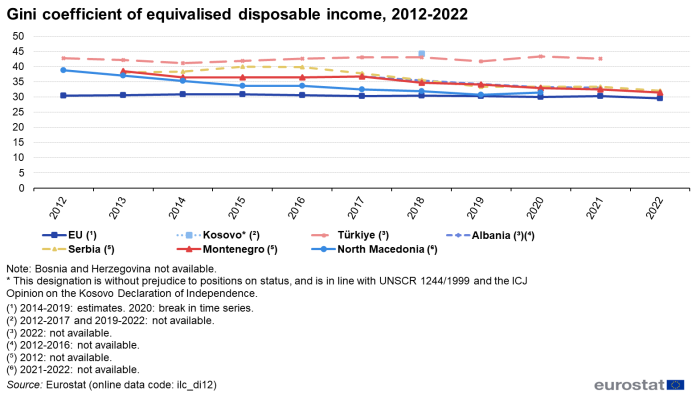
Unemployment by education level
Unemployment is analysed in Figure 2 for the year 2022, broadly broken down by the level of education of the unemployed person. The levels of education considered are the three main aggregates of the International standard classification of education (ISCED): low (less than primary, primary and lower secondary), medium (upper secondary and post-secondary non tertiary) and high (tertiary) level of education.
Data for Montenegro, North Macedonia and Türkiye refer to 2020, instead of 2022. Data for Albania and Kosovo are not available.
In general, the data show that persons that has attained only a low level of education make up a substantially larger share of total unemployment than persons with a medium education level, and these again make up a larger share of total unemployment than persons with a high education level.
In Bosnia and Herzegovina, the unemployment rate of persons having attained only a low education level was 25.1 % in 2022. For persons with a medium education, the unemployment rate was lower, at 13.2 %, and that of persons with high education even lower, at 10.7 %. This means that more than half (51 %) of the unemployed in Bosnia and Herzegovina had a low education level, 27 % had medium education and 22 % a high education level.
The unemployment rates in Montenegro (2020 data instead of 2022) were the highest among the available candidate countries and potential candidate both for persons with low education and persons with medium education, while the unemployment rate for those with high education was the second highest (after North Macedonia). The unemployment rates were 35.2 % for persons with low education, 15.9 % for persons with medium education, and 12.0 % for persons with high education. Although the overall unemployment rate in Montenegro was more than three times higher than in the EU, the structure of unemployment with respect to education level was very similar. In 2020, 56 % of the unemployed in Montenegro had a low level of education, 25 % a medium level and 19 % had a high level.
In North Macedonia (2020 data instead of 2022), the unemployment rates were 21.4 % for persons with low education, 13.8 % for persons with medium education, and 12.9 % for persons with high education. The unemployment rate for persons with high education was the highest among the available candidate countries and potential candidate. This is reflected in the respective shares of total unemployment: while less than half (44 %) of the unemployed had a low education level, 29 % had a medium level and 27 % had a high level.
In 2022, the unemployment rates in Serbia were some of the lowest among the available candidate countries and potential candidate. The unemployment rate among persons with low education was the second lowest (after Türkiye), at 12.2 %, while the rates among those with medium education (9.0 %) and high education (6.2 %) were the lowest. As in North Macedonia, slightly less than half (45 %) of the unemployed in Serbia had a low education level, while one third (33 %) had a medium education level and almost one fifth (23 %) had a high education level.
There was no apparent connection between the unemployment rate and the level of education in Türkiye (2020 data), with similar unemployment rates for all three main education levels: the unemployment rate was 11.8 % both for persons with low education and medium education, while the rate for persons with high education was only somewhat lower at 10.0 %. Persons with low, medium and high education, respectively, made up similar shares of total unemployment; unemployed persons with low and medium education each made up just over one third of total unemployment, each with a share of 35 %, while unemployed with high education made up a little less than one third (30 %).
In the EU, the benefit of education for being employed was clear, with the unemployment rate of persons with low education (11.3 %) was more than double that of persons with medium education (4.9 %) and more than three times that of persons with high education (3.5 %). This is also visible in the shares of total unemployment, with well over half (57 %) of the unemployed having only a low education, higher than in any of the available candidate countries and potential candidate. Correspondingly, only one quarter (25 %) of the unemployed had medium education and less than one fifth (18 %) had high education.
Households with very low work intensity
Persons living in households with low work intensity are persons aged 0-59 that are living in households where the adults aged 18-59 (excluding students), have worked 20 % or less of how much they could have potentially worked during the past year.
The work intensity of a household is the ratio of the total number of months that all working-age household members have worked during the income reference year to the total number of months the same household members could theoretically have worked in the same period. The indicator is based on the EU statistics on income and living conditions (EU-SILC).
The indicator presented in Figure 3 concerns people of working age, defined as 18-59 years.

(%)
Source: Eurostat (ilc_lvhl11)
The proportion of persons who were living in households with very low work intensity in the candidate countries and potential candidate was significantly higher than in the EU throughout the period from 2010 to 2020. The only exception was Türkiye, where the proportion was slightly higher than in the EU (8.1 % in 2020, against 7.7 % in the EU).
The level was higher in the other candidate countries and potential candidate in 2020: North Macedonia had 16.0 %, Montenegro 13.9 %, Serbia, 13.8 % and Albania 11.6 %. The proportion, measured in 2018, was 37.6 % in Kosovo.
The trend of the proportion of persons who were living in households with very low work intensity was generally downward in the candidate countries and potential candidate, with values in 2019 lower than those observed at the beginning of the period. In 2020, the Covid-19 crisis affected the proportion of persons who were living in households with very low work intensity, which led to some increases in most cases, Montenegro and Serbia being the exceptions.
In the EU, the proportion was measured at 8.2 % in 2010, peaked at 9.1 % in 2014, before falling to 6.5 % in 2019 and then rising again to 7.7 % in 2020.
The largest decrease was recorded in Montenegro, where the proportion of persons who were living in households with very low work intensity decreased from 28.2 % in 2012 to less than half (13.9 %) in 2020.
The decrease was also significant in North Macedonia, where the proportion passed from 25.7 % in 2010 to 13.6 % in 2019, and rising to 16.0 % in 2020.
Harmonised index of consumer prices
The Harmonised index of consumer prices (HICP) is the consumer price index as it is calculated in the EU, according to a harmonised approach and a single set of definitions.
Figure 4 presents the HICP (base 2015=100) for the candidate countries and potential candidate and the EU. Except for EU data, conformity with HICP methodological requirements has not been evaluated by Eurostat.

(index 2015 = 100)
Source: Eurostat (prc_hicp_aind)
The trend in the HICP in most candidate countries and potential candidate was quite similar to the trend in the EU, as shown in the graph where the lines mostly overlap. The only exception was Türkiye.
Overall, the HICP increased moderately among the candidate countries and potential candidate during the period 2013 to 2019, with year-on-year changes between -0.5 % (Montenegro, 2020) and 3.4 % (Serbia, 2017), except in Serbia in 2013 (7.7 %) and in Türkiye (see next paragraph). In 2020, during the pandemic, the annual increases in the HICP were smaller than in previous years for four of the six available candidate countries and potential candidate (Montenegro, Serbia, Türkiye and Kosovo). However, in 2021, and linked to the economic recovery from the Covid-19 pandemic, the HICP rebounded and increased stronger than before, with changes in the HICP ranging from 2.3 % (Albania) to 4.1 % (Serbia). In this year as well, Türkiye was an outlier with a year-on-year increase of 19.6 %. In 2022, Russia's war of aggression against Ukraine added further pressure on consumer prices, with the HICP rising by more than 11 % across all candidate countries and potential candidate, except Albania (6.6 %).
In Türkiye, the trend in the HICP (base year 2015=100) was almost exponential, with the index value passing from 79.3 in 2012 to a nearly five times higher value in 2022 (370.8). This corresponded to year-on-year changes in the HICP in the range from 7.5 % (2013) to 19.6 % (2021), before rising sharply to 72.3 % in 2022. From 2017 onwards, each year the HICP increased more than in the previous one, except in 2020 during the Covid-19 pandemic.
The HICP in Serbia stood at 89.4 in 2012. By 2022, it had grown to 128.7. Year-on year, the HICP was 7.7 % higher in 2013 than in 2012. In the years 2014-2021, the year-on-year increases ranged between 1.3 % (2016) and 4.1 % (2021), in 2022 increasing substantially more (11.7 %) than in the preceding period.
In North Macedonia, the HICP index value was 97.3 in 2012 and 125.8 in 2022. From 2013 to 2021, the annual changes in the HICP were between 0.0 % (2014) and 3.4 % in 2021, with close to zero increase in 2014 (0.0 %), 2015 (0.1 %) and 2016 (0.2 %). From 2021 to 2022, the HICP increased by 14.0 %, the second highest increase among the candidate countries and potential candidate in 2022, only below Türkiye.
In Kosovo, the index grew from 100.3 in 2016 (first data available) to 122.0 in 2022, with the annual increases 2017-2021 between 0.2 % (2020) and 3.4 % (2021), rising to 11.6 % in 2022.
Data for the HICP for Montenegro are available from the index base year 2015, with an index value equal to 100.0 by definition, rising to 120.9 by 2022. In terms of annual changes in the HICP, this corresponded to between -0.5 (2020) to 2.8 % (2017) over the period 2016-2021, with the annual change in HICP at 11.9 % in 2022.
In Albania, the HICP was 101.5 in 2016 (first data available) and 120.7 in 2022. The annual increases ranged between 1.7 % (both 2018 and 2019) and 3.2 % (2017, with the change in 2022 (6.6 %) significantly lower than in any of the other candidate countries and potential candidate.
In the EU, the HICP stood at 98.2 in 2012, rising to 118.8 by 2022. From 2013 to 2020, annual changes in HICP ranged between 0.1 % (2015) and 1.8 % (2018), with close to zero increase in 2014 (0.4 %), 2015 (0.1 %) and 2016 (0.2 %). In 2021 HICP rose by 2.9 %, in 2022 by 9.2 %.
Long-term unemployment rate
Long-term unemployment is measured as a percentage of the population in the labour force (which includes both employed and unemployed people) aged 15 to 74 who have been unemployed for 12 months or more. Long-term unemployment increases the risk of a person completely stopping their search for employment (and falling into poverty) and has negative implications for society as a whole.
Figure 5 shows the long-term unemployment rate in the years 2012 to 2022 for the candidate countries and potential candidate and the EU. Data for Albania and Kosovo were not available.
In general, the long-term unemployment rate decreased steadily over the period, both in the candidate countries and potential candidate (with the exception of Türkiye) and in the EU, with a few exceptions mainly linked to the Covid-19 pandemic.
Montenegro started with a rate at 15.8 % in 2012, which had decreased to 11.4 % in 2018 before increasing again to 13.4 % in 2020 (last available data).
The highest long-term unemployment rate was observed in North Macedonia in 2012 (25.5 %). The rate then decreased gradually to 12.4 % in 2020 (last available data).
Only information concerning the final two years was available for Bosnia and Herzegovina: 13.4 % in 2021 and 11.4 % in 2022.
The rate declined considerably in Serbia from the initial 17.4 % (2012) to a level close to the EU rate in 2022 (3.8 %). As can be seen from Figure 5, this decrease was gradual, with the long-term unemployment rate falling by between 3.2 percentage points (pp) (2014) and 0.7 pp (2018) year by year, except a small increase (0.4 pp) in 2021.
The opposite trend was observed in Türkiye, which had a very low long-term unemployment rate in 2012 (1.8 %, against 4.9 % in the EU), which grew continuously to 3.3 % in 2020 (against 2.5 % in the EU). However, Türkiye had the lowest rate of the candidate countries and potential candidate in every year for which data is available.
In the EU the long-term unemployment rate went down from 4.9 % in 2012 to 2.4 % in 2022, after an increase to 2.8 % in 2021.
Inequality of income distribution
The S80/S20 ratio, is a measure of inequality of income distribution. It is calculated as the ratio of total income received by the 20 % of the population with the highest income (the top quintile) to that received by the 20 % of the population with the lowest income (the bottom quintile).
Figure 6 presents the trend of the S80/S20 ratio in the candidate countries and potential candidate and in the EU over the period 2012-2022. In general, it shows a reduction of the inequalities in the candidate countries and potential candidate, while in the EU the ratio remained more or less stable at around 5 (4.98 in 2012 and 4.74 in 2022).
Only 2018 data were available for Kosovo, showing the highest inequality ratio observed among the group: 15.58.
In Türkiye the indicator fluctuated around the value of 9 (almost double compared with the EU). It was 9.33 in 2012 and 8.80 in 2021, which was the highest value recorded in the candidate countries and potential candidate in the last two years of the observation period.
In North Macedonia the ratio fell from 10.20 in 2012 to 5.92 in 2020.
Only data from 2017 to 2021 were available for Albania. They showed a reduction from 7.47 to 5.72.
The inequality ratio decreased in Montenegro from 8.54 in 2013 to 5.58 in 2022.
In Serbia the ratio increased from 8.59 in 2013 to 11.02 in 2016 and then decreased rapidly to 5.54 in 2022.
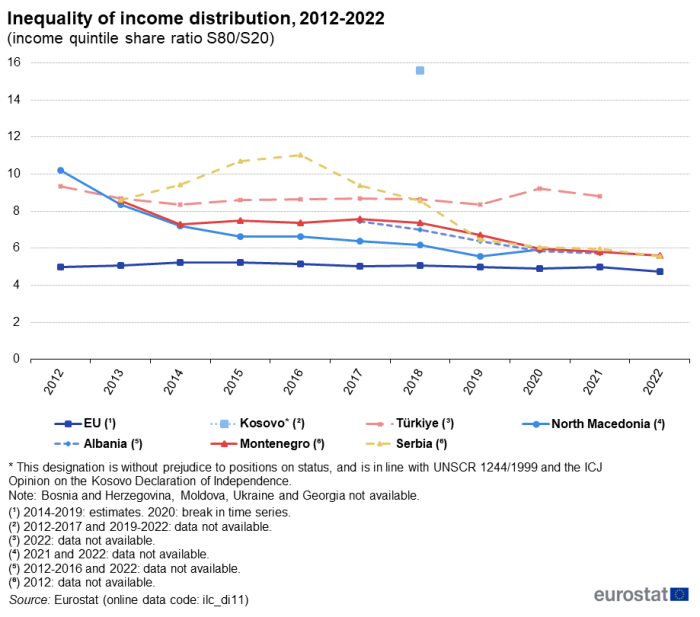
(income quantile share ratio S80/S20)
Source: Eurostat (ilc_di11)
Risk of poverty
The at-risk-of-poverty rate is the proportion of the population with an equivalised disposable income below the poverty threshold. This indicator can be calculated either before social transfers or after social transfers.
The difference between the two reflects the proportion of the population moved above the threshold as a result of receiving social transfers. Social transfers cover the social help given through benefits such as: old-age and survivors’ (widows’ and widowers’) pensions; unemployment, family-related, sickness and invalidity, education-related and other benefits; housing allowances; and social assistance.
As the poverty threshold is set independently for each enlargement country, the indicator reflects low income in comparison with other residents in the same economy. This does not necessarily imply an extremely low standard of living.
The most recent data from the candidate countries and potential candidate on the proportion of the population at risk of poverty after social transfers ranged from 20.0 % in Serbia in 2022 to 27.9 % in Kosovo (2018 data), with Montenegro (20.3 %), Albania (22.0 %; 2021 data) and Türkiye (22.4 %; 2021 data) also falling within this range. All were higher than in the EU, where the proportion in 2022 was 16.5 %.
At the beginning of the observation period, North Macedonia had the highest proportion of population at risk of poverty after social transfers, 26.2 % in 2012, but the proportion decreased to 21.8 % in 2020 (more recent data not available), also within the range mentioned above.
No data are available for Bosnia and Herzegovina.
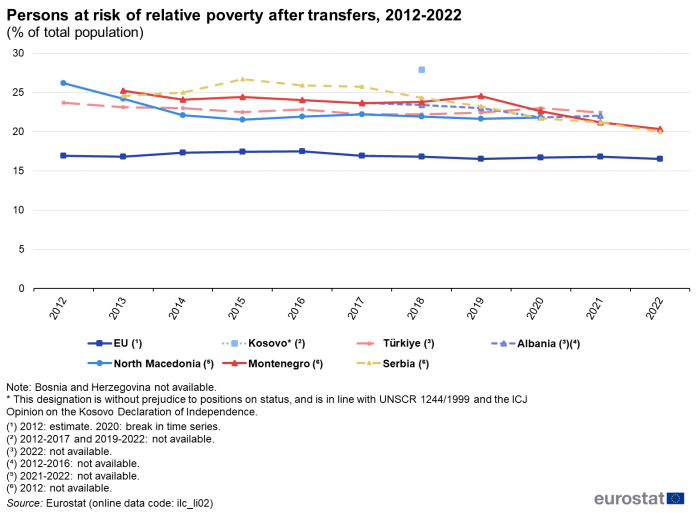
(% of total population)
Source: Eurostat (ilc_li02)
Source data for tables and graphs
Data sources
The data used in this article are mainly derived from EU statistics on income and living conditions (EU-SILC), data which are compiled annually and are the main source of statistics that measure income and living conditions in Europe. EU-SILC is an instrument that aims to collect timely and comparable data on income, poverty, social inclusion and living conditions, in both monetary and non-monetary terms. The data are generally collected for private households and household members. EU-SILC provides both cross-sectional data and longitudinal data (typically over a four-year period).
Among the candidate countries and potential candidate, Türkiye started the full implementation of EU-SILC in 2006, while North Macedonia launched it in 2010, Montenegro and Serbia in 2013, Albania in 2017, Kosovo in 2018 and Bosnia and Herzegovina in 2022.
The legal basis for this data collection exercise is Regulation (EU) 2019/1700 of the European Parliament and of the Council of 10 October 2019 establishing a common framework for European statistics relating to persons and households, based on data at individual level collected from samples (Integrated European Social Statistics – IESS).
Information concerning the current statistical legislation on income and living conditions can be found in the 'Legislation' section of the dedicated section on 'Income and living conditions' on Eurostat's website.
The main source for European labour force statistics is the European Union labour force survey (EU LFS). This household survey is carried out in all EU Member States in accordance with European legislation and provides figures at least every quarter.
Among the candidate countries and potential candidate, Bosnia and Herzegovina, Montenegro, North Macedonia, Serbia and Türkiye have implemented the EU-LFS instrument and conduct the labour force survey according to the same guidelines, methodology and standards as the EU countries.
Information concerning the current statistical legislation on statistics on employment and unemployment can be found in the 'Legislation' section of the dedicated section on 'Employment and unemployment (Labour Force Survey – LFS)' on Eurostat's website.
The Harmonised index of consumer prices (HICP) is designed to be a measure of pure price change for goods and services, and measures the changing cost of a fixed basket of goods and services over time. . The HICP is computed as a 'Laspeyres-type price index' according to harmonised definitions. It is an important basis for international comparisons of consumer price inflation from the European Union perspective. National HICP data are calculated by the national statistical institutes, while the country-special aggregates and the European aggregates are produced by Eurostat.
Eurostat publishes HICP data for several of the candidate countries and potential candidate. Consumer price indices that classify product according to the European Classification of Individual Consumption According to Purpose (ECOICOP) are available for Albania since 2015, Montenegro since 2014, North Macedonia since 2004, Serbia since 2005 and Kosovo since 2015. However, the conformity of these data with the methodological requirements of HICP has not been evaluated by Eurostat.
Information concerning the current statistical legislation on the harmonised indices of consumer prices can be found in the 'Legislation' section of the dedicated section on 'Harmonised indices of consumer prices (HICP)' on Eurostat's website.
Context
The Covid-19 crisis and the subsequent cost-of-living crisis have had a direct and indirect impact on the general population but in particular on vulnerable groups such as the elderly, people with disabilities, young people, low-wage earners, part-time workers and people with precarious work contracts. Pressure on living conditions of households have increased through rising consumer prices, together with a generally uncertain economic environment.
The EU and the EU Member States operate an open method of coordination for social protection and social inclusion. This aims to promote social cohesion and equality through adequate, accessible and financially sustainable social protection systems and social inclusion policies. As such, the EU provides a framework for national strategy development, as well as the opportunity to discuss and learn from best practices and to coordinate policies between EU Member States in areas such as: building a fairer and more inclusive EU, social protection and social inclusion, and pensions.
At the start of March 2021, the European Commission outlined its ambition for an EU that focuses on education, skills and jobs for the future and targets a fair, inclusive and resilient socioeconomic recovery. The European Pillar of Social Rights Action Plan outlines a range of actions designed to promote social rights through the active involvement of social partners and civil society. It also proposes employment, skills and social protection headline targets for the EU. One of the headline targets relates specifically to living conditions, namely that the number of people at risk of poverty or social exclusion should decrease by at least 15 million persons (of which, at least five million should be children) between 2019 and 2030. The Action Plan highlights how the principles of the social pillar might be implemented, with the aim of building a stronger social Europe by 2030.
While basic principles and institutional frameworks for producing statistics are already in place, the candidate countries and potential candidate are expected to progressively increase the volume and quality of their data and to transmit these data to Eurostat in the context of the EU enlargement process. EU standards in the field of statistics require the existence of a statistical infrastructure based on principles such as professional independence, impartiality, relevance, confidentiality of individual data and easy access to official statistics; they cover methodology, classifications and standards for production.
Eurostat has the responsibility to ensure that statistical production of the candidate countries and potential candidate complies with the EU acquis in the field of statistics. To do so, Eurostat supports the national statistical offices and other producers of official statistics through a range of initiatives, such as pilot surveys, training courses, traineeships, study visits, workshops and seminars, and participation in meetings within the European Statistical System. The ultimate goal is the provision of harmonised, high-quality data that conforms to European and international standards.
Additional information on statistical cooperation with the candidate countries and potential candidate is provided in the Statistics explained background article Enlargement policy and statistical cooperation.
Notes
- ↑ This designation is without prejudice to positions on status, and is in line with UNSCR 1244/1999 and the ICJ Opinion on the Kosovo Declaration of Independence.
Explore further
Other articles
- Living conditions in Europe - poverty and social exclusion — online publication
- Living conditions in Europe - income distribution and income inequality — online publication
- Enlargement countries — statistical overview — online publication
- Statistical cooperation — online publication
Database
Thematic section
Publications
- Statistical books/pocketbooks
- Key figures on enlargement countries — 2019 edition
- Key figures on enlargement countries — 2017 edition
- Key figures on the enlargement countries — 2014 edition
- Factsheets
- Basic figures on the candidate countries and potential candidates — Factsheets — 2023 edition
- Basic figures on Western Balkans and Türkiye — Factsheets — 2022 edition
- Basic figures on enlargement countries — Factsheets — 2021 edition
- Leaflets
- Basic figures on enlargement countries — 2020 edition
- Basic figures on enlargement countries — 2019 edition
- Basic figures on enlargement countries — 2018 edition
- Basic figures on enlargement countries — 2016 edition
- Enlargement countries — Demographic statistics — 2015 edition
- Key figures on the enlargement countries — Population and social conditions — 2013 edition
Methodology
- Income and living conditions (ilc) (ESME metadata file — ilc)
- Employment and unemployment (Labour force survey) (employ) (ESME metadata file — employ)
- LFS main indicators (lfsi) (ESME metadata file — lfsi)
- LFS series - detailed annual survey results (lfsa) (ESME metadata file — lfsa)
- Harmonised index of consumer prices (HICP) (prc_hicp) (ESME metadata file — prc_hicp)
External links
Legislation
- Working together, working better: a new framework for the open coordination of social protection and inclusion policies in the European Union (COM(2005) 706 final)
Framework Regulation on Integrated European Social Statistics (IESS)
- Regulation (EU) 2019/1700 establishing a common framework for European statistics relating to persons and households (Integrated European Social Statistics – IESS)
- Regulation (EU) 2019/2180 specifying the detailed arrangements and content for the quality reports pursuant to Regulation (EU) 2019/1700 (structure of quality reports elated to datasets to be transmitted to Eurostat)
- Regulation (EU) 2019/2181 specifying technical characteristics as regards items common to several datasets pursuant to Regulation (EU) 2019/1700 (technical characteristics of the statistical populations and observation units, descriptions of variables and of the statistical classifications)
- Regulation (EU) 2020/256 supplementing Regulation (EU) 2019/1700 by establishing a multiannual rolling planning (data collections for all domains from 2021 until 2028)
European survey on income and living conditions (EU-SILC)
- Regulation (EU) 2019/2242 specifying the technical items of data sets, establishing the technical formats and specifying the detailed arrangements and content of the quality reports on the organisation of a sample survey in the income and living conditions domain pursuant to Regulation (EU) 2019/1700
- Regulation (EU) 2020/258 supplementing Regulation (EU) 2019/1700 by specifying the number and the titles of the variables for the income and living conditions domain
European labour force survey (EU-LFS)
- Regulation (EU) 2019/2240 specifying the technical items of the data set, establishing the technical formats for transmission of information and specifying the detailed arrangements and content of the quality reports on the organisation of a sample survey in the labour force domain in accordance with Regulation (EU) 2019/1700
- Regulation (EU) 2020/257 supplementing Regulation (EU) 2019/1700 by specifying the number and the title of the variables for the labour force domain
Harmonised indices of consumer prices (HICP)
- Regulation (EU) 2016/792 on harmonised indices of consumer prices and the house price index
- Regulation (EU) 2020/1148 laying down the methodological and technical specifications in accordance with Regulation (EU) 2016/792 as regards harmonised indices of consumer prices and the house price index
- Regulation (EU) 2024/1720 amending Regulation (EU) 2020/1148 as regards the index compilation of the harmonised indices of consumer prices

